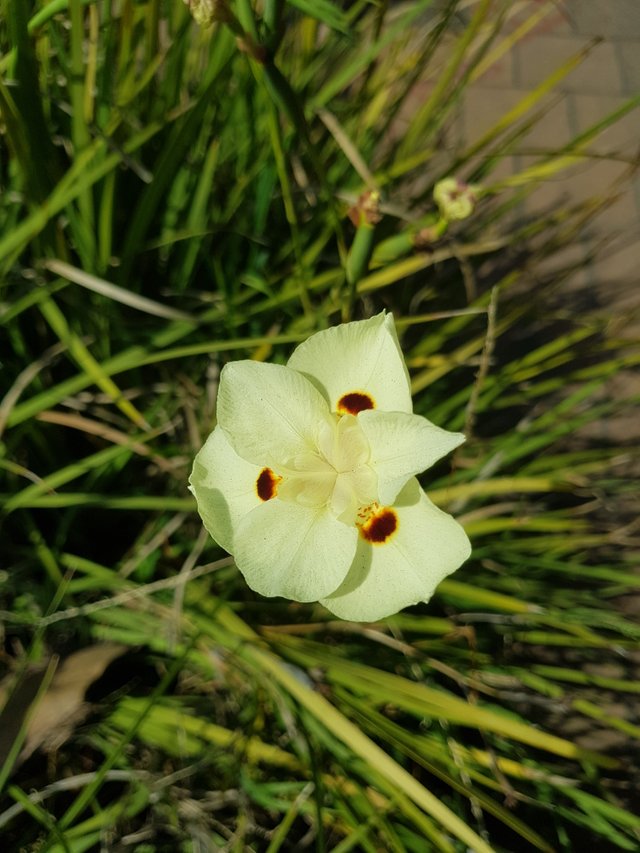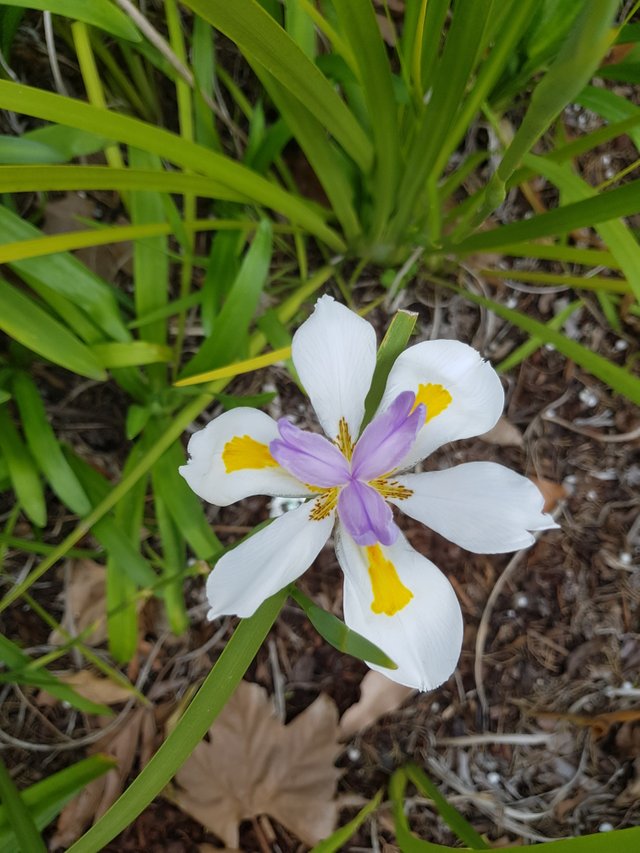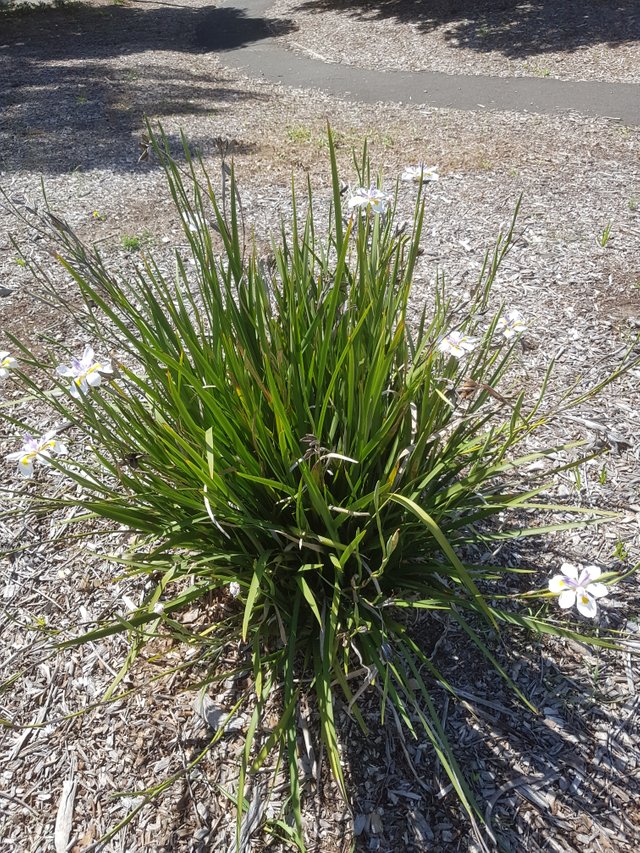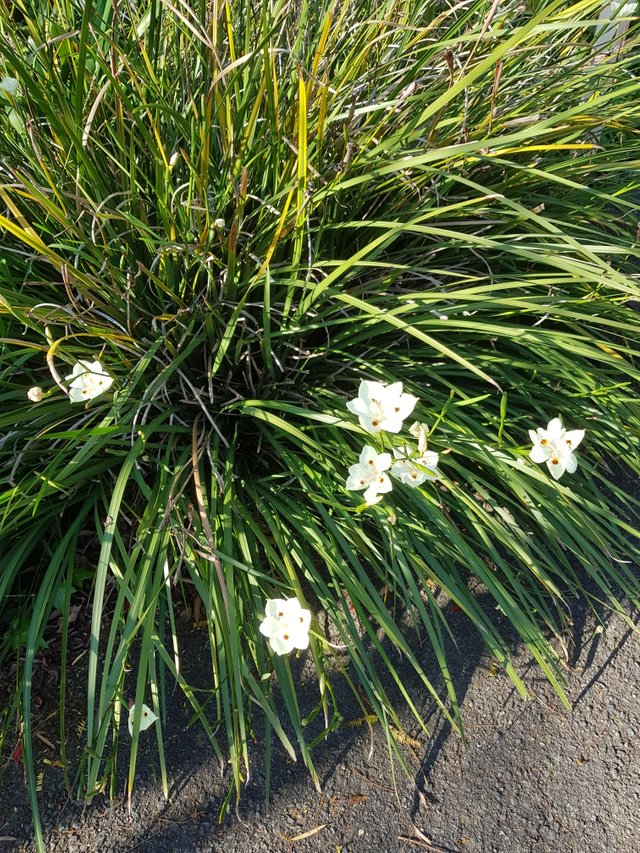Un-killable Dietes
If you kill one of these plants, you have a black thumb, not a green thumb !! :) Dietes is the Botanical name for the plant called the Fortnight Lily, or African Iris, along with several other common names. They are not related to Iris, this is only a common name used for them ! This plant is tough and very hardy, but will always benefit from extra care, and will look better for it. Most species of this plant are from Africa, so it is suited for temperate and warmer climates, and flowers for most of the year. There are only about 6 species of this plant, but two of them, Dietes bicolor and Dietes iridoides are most common in Sydney.
Dietes bicolor is the larger plant of the two, having long arching sword-like leaves with pale yellow flowers and darker brown spots on the petals. The plant grows into a large clump and is very attractive when mature. Dietes iridoides is more of an upright clumping plant, the shorter sword-like leaves pointing straight up. The flowers are an attractive mix of yellow, white and blue.
Pruning off the dead foliage and flower heads will improve the look of the plants, and give it a sunny spot and well-drained soil for best results. I took these photos in different locations around Sydney.




Two-color diets and Iris-shaped diets A completely unpretentious rhizomatous plant, practically not damaged by pests, blooms for a long time and abundantly. Can be grown as a houseplant or garden plant.
Perennial, evergreen, rhizomatous plant up to 1 m tall. The leaves are long, narrow, sword-shaped, dark green. The flowers are large, white, cream or yellowish with three dark maroon spots.
Here are some photos from the Internet
http://edenland.com.ua/semena/dietes-dvukhtsvetnyj.html
https://m.my.mail.ru/inbox/temko/photo/15419/16592.html
Thank you for sharing a new type of plant for me :)
Fav. comment Award ! Thanks for your good selection of Pics.
Amazing flowers @ctrl-alt-nwo! A very hardy landscaping plant with a clumping grass-like appearance which produces pale yellow flowers during Spring and Summer. Great for borders in full sun positions.
Synonyms (AKA): Peacock Fower, Wild Iris
Typical height: 60 to 80cm
Minimum temperature tolerance: Tolerates frost
Climate: Grows well in most parts of Australia
Light conditions: Full sun to part shade
Growth habit: Clumping
Growing conditions: Well drained soil
Flowers: Spring / Summer
Origin: South Africa
A source: http://www.bambooland.com.au/dietes-bicolour
Silly sausage Award ! Great choice of Pics, thanks.
Wild iris, or butterfly plant, as it is also called, is a delight to grow. It is a tough plant that will grow in most soils and, once established, will survive harsh growing conditions – even tolerating drought. Conversely, wild iris (Dietes spp.) will also grow in boggy gardens. It can be grown in full sun or semi-shade and is usually pest- and disease-free.
There are five indigenous species of wild iris – Dietes bicolor, D. butcheriana, D. flavida, D. grandiflora and D. iridioides. All these species, but especially the yellow wild iris (D. bicolor) and the large wild iris (D. grandiflora), make attractive garden and landscape plants. The blooms of the latter two are borne on top of long flower stalks above 90cm-tall foliage. Their leaves are evergreen and grass-like, and the plants grow to form attractive clumps.
https://www.lifeisagarden.co.za/dietes-pretty-tough-plants/
Fav. comment Award ! Well done on your selection of Pics.
@ctrl-alt-nwo,
I can assure I didn't see these flowers in my country! It's a bush type! Personally I hate bush type plants! Coz sneaks can use it as a hidden place! But I like these flowers! They looks so wonderful and cute! Nice photography and a description about them! Thank you!
Cheers~
One of the most versatile plants around and a great plant for beginning gardeners. This African native can tolerate virtually any soil conditions from drought to moist soil found at the water’s edge. Requires little maintenance to maintain a neat appearance. Just remove faded flowers to keep plant looking fresh. The spiky foliage adds great texture and interest to formal settings or plants can be naturalized for a casual, carefree look. Blooms last only a day or two but are produced over a long season through the spring and summer.
Prepare the garden by breaking up the existing soil (use a hoe, spade, or power tiller) to a depth of 12-16” (30-40cm). Add organic matter such as manure, peat moss or garden compost until the soil is loose and easy to work. Organic ingredients improve drainage, add nutrients, and encourage earthworms and other organisms that help keep soil healthy. Give plants an extra boost by adding a granulated starter fertilizer or all-purpose feed that encourages blooming (for example fertilizers labeled 5-10-5).
https://www.mygardenlife.com/plant-library/6661/dietes/iridioides
Thanks again for sharing some lovely photographs.
Shared on twitter promoting great quality content on #Steemit.
#Promo-Steem #steemtalent #JoinSteemit #Steemit
Un-killable Dietes. #STEEM #steemtalent #JoinSteemit #Steemit
#garden #gardening #gardensworld #plant #life #blog #blogger #australia #photography #photographer
https://twitter.com/StephenPKendal/status/1054378491666415618
Thanks for sharing on Twitter again too !
Those are rare in las vegas... we only have palm trees and cactuses here haha
I was there about 20 years ago. Loved it !
Dietes grandiflora is a perennial, evergreen plant which grows up to 1.5m in large clumps. The plants grow from underground rhizomes.The long, rigid, sword-shaped leaves, held in a fan shape, are dark green and may reach up to 1m long and 15-20mm wide.The attractive flowers, held on erect slender stems about 1m in length, are large (about 100mm across) and are white with yellow nectar guides and outer tepals and violet central segments.
The flowers are borne in mass at certain periods — often after rain in summer. The individual flowers do not last more than a couple of days (so are of no use in a vase) however, the plant bears so many flowers during the peak period that the plant looks most striking. This plant is occasionally called the "Fairy Iris" because the fragile white petals not only look like fairy wings, but also have a tendency to disappear mysteriously overnight! The large wild iris fruit is a large capsule up to 45mm which is held erect and splits open to release shiny, dark brown seeds.
Source: http://pza.sanbi.org/dietes-grandiflora
Fortnight lily
Formerly classified in the genus Moraea, and is still called morea iris by some gardeners. These are evergreen perennials with spreading fans of stiff, leathery sword shaped leaves up to 2 ft (0.6 m) in length but only 0.75 in (1.9 cm) wide. The upright clumps of leaves are held in a vertical fanlike plane and they spread on creeping rhizomes which sometimes ascend a few inches. The 2-4 ft (0.6-1.2 m) flowering stalks, which are perennial, are branched and stiffly wiry, bearing a succession of short-lived irislike flowers throughout spring and summer.
The flowers, rather flattened and nearly 3 in (7.6 cm) across, are milky white with yellow markings on the three larger tepals. (The three petals and three similar sepals of iris flowers are collectively called tepals.) Fortnight lily fruits are 1-2 in (2.5-5.1 cm) football shaped, three-sided capsules.
The fortnight lilies are often grown in borders because the narrow leaves are evergreen, and provide a strong vertical element. They're good along foundations, too. Fortnight lilies eventually form dense fan shaped clumps of leaves, and make a dramatic ground cover under large, tall trees. The flowers are beautiful, and although each lasts only a day, they are produced in profusion over an extended period from spring until late summer. They usually come in bursts, with a fortnight (two weeks) of rest between flowering events. Fortnight lilies seem to perform best in the light dappled shade of tall, open trees.
References1234